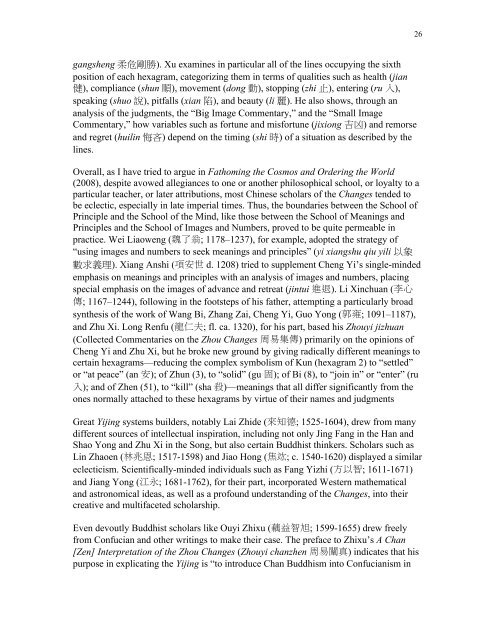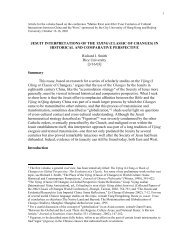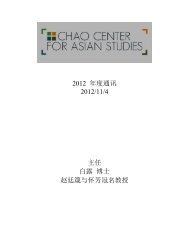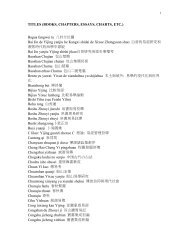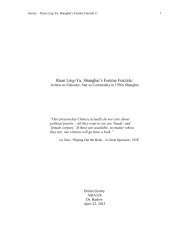Key Concepts of Fate and Prediction in the Yijing - Chao Center for ...
Key Concepts of Fate and Prediction in the Yijing - Chao Center for ...
Key Concepts of Fate and Prediction in the Yijing - Chao Center for ...
You also want an ePaper? Increase the reach of your titles
YUMPU automatically turns print PDFs into web optimized ePapers that Google loves.
26gangsheng ). Xu exam<strong>in</strong>es <strong>in</strong> particular all <strong>of</strong> <strong>the</strong> l<strong>in</strong>es occupy<strong>in</strong>g <strong>the</strong> sixthposition <strong>of</strong> each hexagram, categoriz<strong>in</strong>g <strong>the</strong>m <strong>in</strong> terms <strong>of</strong> qualities such as health (jian), compliance (shun ), movement (dong ), stopp<strong>in</strong>g (zhi ), enter<strong>in</strong>g (ru ),speak<strong>in</strong>g (shuo ), pitfalls (xian ), <strong>and</strong> beauty (li ). He also shows, through ananalysis <strong>of</strong> <strong>the</strong> judgments, <strong>the</strong> “Big Image Commentary,” <strong>and</strong> <strong>the</strong> “Small ImageCommentary,” how variables such as <strong>for</strong>tune <strong>and</strong> mis<strong>for</strong>tune (jixiong ) <strong>and</strong> remorse<strong>and</strong> regret (huil<strong>in</strong> ) depend on <strong>the</strong> tim<strong>in</strong>g (shi ) <strong>of</strong> a situation as described by <strong>the</strong>l<strong>in</strong>es.Overall, as I have tried to argue <strong>in</strong> Fathom<strong>in</strong>g <strong>the</strong> Cosmos <strong>and</strong> Order<strong>in</strong>g <strong>the</strong> World(2008), despite avowed allegiances to one or ano<strong>the</strong>r philosophical school, or loyalty to aparticular teacher, or later attributions, most Ch<strong>in</strong>ese scholars <strong>of</strong> <strong>the</strong> Changes tended tobe eclectic, especially <strong>in</strong> late imperial times. Thus, <strong>the</strong> boundaries between <strong>the</strong> School <strong>of</strong>Pr<strong>in</strong>ciple <strong>and</strong> <strong>the</strong> School <strong>of</strong> <strong>the</strong> M<strong>in</strong>d, like those between <strong>the</strong> School <strong>of</strong> Mean<strong>in</strong>gs <strong>and</strong>Pr<strong>in</strong>ciples <strong>and</strong> <strong>the</strong> School <strong>of</strong> Images <strong>and</strong> Numbers, proved to be quite permeable <strong>in</strong>practice. Wei Liaoweng (; 1178–1237), <strong>for</strong> example, adopted <strong>the</strong> strategy <strong>of</strong>“us<strong>in</strong>g images <strong>and</strong> numbers to seek mean<strong>in</strong>gs <strong>and</strong> pr<strong>in</strong>ciples” (yi xiangshu qiu yili ). Xiang Anshi ( d. 1208) tried to supplement Cheng Yi’s s<strong>in</strong>gle-m<strong>in</strong>dedemphasis on mean<strong>in</strong>gs <strong>and</strong> pr<strong>in</strong>ciples with an analysis <strong>of</strong> images <strong>and</strong> numbers, plac<strong>in</strong>gspecial emphasis on <strong>the</strong> images <strong>of</strong> advance <strong>and</strong> retreat (j<strong>in</strong>tui ). Li X<strong>in</strong>chuan (; 1167–1244), follow<strong>in</strong>g <strong>in</strong> <strong>the</strong> footsteps <strong>of</strong> his fa<strong>the</strong>r, attempt<strong>in</strong>g a particularly broadsyn<strong>the</strong>sis <strong>of</strong> <strong>the</strong> work <strong>of</strong> Wang Bi, Zhang Zai, Cheng Yi, Guo Yong (; 1091–1187),<strong>and</strong> Zhu Xi. Long Renfu (; fl. ca. 1320), <strong>for</strong> his part, based his Zhouyi jizhuan(Collected Commentaries on <strong>the</strong> Zhou Changes ) primarily on <strong>the</strong> op<strong>in</strong>ions <strong>of</strong>Cheng Yi <strong>and</strong> Zhu Xi, but he broke new ground by giv<strong>in</strong>g radically different mean<strong>in</strong>gs tocerta<strong>in</strong> hexagrams—reduc<strong>in</strong>g <strong>the</strong> complex symbolism <strong>of</strong> Kun (hexagram 2) to “settled”or “at peace” (an ); <strong>of</strong> Zhun (3), to “solid” (gu ); <strong>of</strong> Bi (8), to “jo<strong>in</strong> <strong>in</strong>” or “enter” (ru); <strong>and</strong> <strong>of</strong> Zhen (51), to “kill” (sha )—mean<strong>in</strong>gs that all differ significantly from <strong>the</strong>ones normally attached to <strong>the</strong>se hexagrams by virtue <strong>of</strong> <strong>the</strong>ir names <strong>and</strong> judgmentsGreat Yij<strong>in</strong>g systems builders, notably Lai Zhide (; 1525-1604), drew from manydifferent sources <strong>of</strong> <strong>in</strong>tellectual <strong>in</strong>spiration, <strong>in</strong>clud<strong>in</strong>g not only J<strong>in</strong>g Fang <strong>in</strong> <strong>the</strong> Han <strong>and</strong>Shao Yong <strong>and</strong> Zhu Xi <strong>in</strong> <strong>the</strong> Song, but also certa<strong>in</strong> Buddhist th<strong>in</strong>kers. Scholars such asL<strong>in</strong> Zhaoen (; 1517-1598) <strong>and</strong> Jiao Hong (; c. 1540-1620) displayed a similareclecticism. Scientifically-m<strong>in</strong>ded <strong>in</strong>dividuals such as Fang Yizhi (; 1611-1671)<strong>and</strong> Jiang Yong (; 1681-1762), <strong>for</strong> <strong>the</strong>ir part, <strong>in</strong>corporated Western ma<strong>the</strong>matical<strong>and</strong> astronomical ideas, as well as a pr<strong>of</strong>ound underst<strong>and</strong><strong>in</strong>g <strong>of</strong> <strong>the</strong> Changes, <strong>in</strong>to <strong>the</strong>ircreative <strong>and</strong> multifaceted scholarship.Even devoutly Buddhist scholars like Ouyi Zhixu (; 1599-1655) drew freelyfrom Confucian <strong>and</strong> o<strong>the</strong>r writ<strong>in</strong>gs to make <strong>the</strong>ir case. The preface to Zhixu’s A Chan[Zen] Interpretation <strong>of</strong> <strong>the</strong> Zhou Changes (Zhouyi chanzhen ) <strong>in</strong>dicates that hispurpose <strong>in</strong> explicat<strong>in</strong>g <strong>the</strong> Yij<strong>in</strong>g is “to <strong>in</strong>troduce Chan Buddhism <strong>in</strong>to Confucianism <strong>in</strong>


